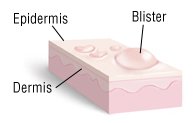We've all gotten those annoying blisters at one time or another from new shoes or shoes that are just a wee bit tight for our feet. Here is some information that you may find helpful about "friction blisters" and how to treat them!
A friction blister is a soft pocket of raised skin filled with clear fluid caused by irritation from continuous rubbing or pressure. Friction blisters usually occur on the feet, where tight or poor-fitting shoes can rub and irritate delicate toes and heels for long periods of time. This type of irritation causes minor damage to the skin and the tissue just beneath the skin, then fluid accumulates just beneath the outermost layer of skin. If the irritation is enough to damage small blood vessels, the blister also may contain blood, and is then called a blood blister.
 |
Symptoms
A friction blister is a small pocket of puffy, raised skin containing clear fluid. It is usually painful when touched. A blister can appear anywhere.
Diagnosis
Blisters can be diagnosed by looking at them. In short, if it looks like a blister and feels like a blister, and if it's in a place that could have been irritated by pressure or rubbing, it likely is a blister.
Expected Duration
Friction blisters typically drain on their own within days. A new layer of skin forms beneath the blister, and eventually the blistered skin peels away.
If pressure or friction continues in the same area, the blister may last two weeks or longer. Continued friction may rub away the delicate top skin layer, and the blister may break open, ooze fluid and run the risk of becoming infected or developing into a deeper wound. If the irritation is mild, the blister may heal despite continued irritation, and eventually a callus will form.
Prevention
The best way to prevent friction blisters is to wear shoes that fit your feet well, so that the shoe is not tight anywhere and does not slide up and down your heel when you walk. Wear socks with shoes to protect your feet and prevent irritation, and try to keep your feet dry. If another activity is causing blisters — for example, if learning to play golf is causing blisters on your hands — ask an instructor to point out other ways to perform the same activity in a nonirritating way, and take advantage of protective devices, such as gloves.
Treatment
Because blisters typically get better on their own in just a few days, generally no special treatment is required other than to keep the blisters clean and dry. Because the skin provides a natural protection against infection, a blister should be left intact if possible. Do not try to drain the blister or pierce or cut away the overlying skin. Try to avoid further irritation, or protect the blister with a sterile bandage if continued irritation is unavoidable. If the blister breaks on its own, wash the area with soap and water, gently pat dry, use an antibacterial ointment and cover it with a bandage.
People with diabetes and people who cannot reach blisters easily (because of a physical disability or other ailment) may need to have their blisters evaluated by a foot specialist (podiatrist) or other health care professional. People with diabetes often have nerve or circulation problems that make it more difficult to recognize wounds, and that cause wounds to heal more slowly. In these people, a simple foot blister might go unrecognized and could become infected. People with diabetes need to care for their feet daily and examine them for sores or blisters.
I can say that I enjoyed reading about blisters. I myself am Diabetic and you are so correct about taking care of your legs and feet. First thing my Dr said was, keep an eye on your sugar levels, your legs and feet. I also where shoes that are wide now.
ReplyDeleteAwesome tip!
ReplyDeleteI always seem to forget these things come summer time with all my sandals & cute shoes that give me blister after blister. You's think a girl would learn! LOL
ReplyDeleteYou are so right about blisters on the feet. But you can also get them on your hands. Unfortunately I did just that yesterday. I was trying to get a stain out of a shirt and was rubbing the shirt together, ending up with blisters on 4 fingers. Ouch! and to add insult to injury, the stain won!
ReplyDelete